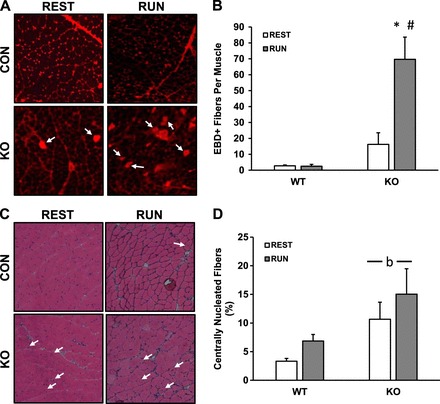Fig. 7.

Downhill running leads to muscle damage in LKB1-deficient skeletal muscle. WT and skeletal muscle-specific LKB1 knockout (KO) mice were injected with EBD and then allowed normal cage activity (REST) or run downhill intermittently for 1 h (RUN). Immediately (A and B; n = 8–9/group) or at 5 days (C and D; n = 5–9/group) quadriceps muscles were collected and analyzed for EBD positive (EBD+) cells (A and B), or for centrally nucleated muscle fibers via hematoxylin and eosin (H&E) staining (C and D). A: representative images of EBD+ fibers in muscles from WT and KO mice after REST or RUN. Arrows indicate EBD+ fibers. B: average EBD+ fibers per quadriceps muscle. C: representative H&E stains of muscles from WT and KO mice after REST or RUN. Arrows indicated fibers with centrally localized nuclei. D: average percentage of centrally nucleated muscle fibers. *Significant difference (P ≤ 0.05) vs. corresponding REST group. #Significant difference vs. corresponding WT group. bMain effect of genotype.
